Garbage as far as the eye can sea.
Plastic. Everyone is familiar with it; it’s used in the majority of products that are available to us. Yet because it is so frequent, many people do not take enough time to consider the effects that such a large industry has on the environment. Unknown to many, over 1 trillion plastic bags are used worldwide every year. According to the China Trade News, China alone uses 3 billion plastic bags per day. All this amounts to about 1 million plastic bags being used every minute. However, despite the immense usage of plastics bags, hardly any actually end up being recycled. For example, according to the BBC, in the UK, only 1 in 200 plastic bags get recycled. As such, more than 3.5 million tons of plastic was discarded in 2008 alone. This amounts to a massive global footprint, whose blame can be shared throughout the world.
What people fail to understand is that it takes up to 1,000 years for a plastic bag to degrade. This means that when you throw out the plastic bag that your subway sandwich came in only a few minutes ago, that bag will still be around a millennium later, long after your have passed away.
Plastic In Our World
So, from this, one can understand that every piece of plastic ever made, since its creation in 1862 by Alexander Parkes, is still floating around somewhere today. As such, where is all this plastic ending up? There are many theories and myths out there, but one of the main ones is of an island of plastic in the middle of the ocean that is bigger than the state of Texas. The sad thing is that this story holds more truth than fiction.
News broadcast on the Great Pacific Gyre found on YouTube
The Pacific Gyre
Every story about the island is slightly different, just as every researcher has observed a different thing. As such, many people have written it off as an urban myth. The fact is that there is a vortex of currents called to Pacific Gyre, located in the Pacific Ocean and stretching from coast of California to Japan. This current formation has historically been the collecting point for all different kinds of debris. However, in recent history, it has become known as the collection point for plastic. It is estimated that over 90% of the floating debris is plastic. Originating from land, waterways and wind, millions of tons of plastic are cast into the environment from all over the world. This has resulted in some areas having six times more plastic than plankton, which is the major source of food for many marine organisms. Basically, we have created an ecological disaster.
A scientist, named captain Charles Moore, who is the captain of an oceanographic research vessel, took a detour into North Pacific Gyre, on his way back to the United States from Australia. What he found was an ocean filled with tiny pieces of plastic. He and his crew cast plastic trolls into the water and found they came back filled with plastic. Moore commented that many people believe that the worst kind of spill for the ocean is oil, but the reality is that the worst is really the plastic bottles we throw away.
Effects on Humans
Amazingly, this section of ocean, literally in the middle of nowhere, with no land or other ships around, holds one of the highest concentrations of plastic per square inch of water. The danger here lies in the main component of plastic, Bisphenol A. This compound, used for the plastic polycarbonates, is made at 7 billion pounds per year and is completely non-recyclable. The scary part is that evidence from all over the world says that every person examined has these chemicals in their bodies. Worse still, in Japan, women who had increased levels of Bisphenol A were the ones who were unable to get pregnant, and continually had miscarriages.
Effects on Animals
But how is it possible that our trash is coming back to haunt us? It can be explained with one word: bioaccumulation. The ecological effects of plastic in the oceans, starts out at the smallest scale: plankton. There is six times more plastic than plankton in many parts of the ocean, specifically in the Pacific Gyre. Since plankton is one of the most common food sources for marine life, animals are mistaking small pieces of plastic for their food. For example, turtles may mistake a floating plastic bag for a jellyfish, which they can consume. Thus, there is a build up of Bisphenol A in animals. These are then the prey of other, larger animals, and as such bioaccumulation begins. It doesn’t stop until it reaches the top of the food chains and humans. As a result, the contaminations and poison associated with plastic is passed on through nearly every organism. Even despite bioaccumulation, many marine animals die due to the direct effects of being caught in or choking on plastic pieces.
The main problem with plastic is that it doesn’t chemically break down over time; it simply slowly degrades into smaller and smaller pieces. As a result, the chemicals in this material, specifically the Bisphenol A, increases in concentration, as the pieces get smaller. So it becomes increasingly toxic and near impossible to clean up. These toxins all work their way up the food chain back onto our plates at home.
Since ocean is full of plastic products, the really mystery is, where in the world is there not exposure to them?
What can we do?
Although it seems like too big of a problem to even think about dealing with, we cannot give up hope. There are many ways that you can reduce your plastic intake and output.
- Use reusable shopping bags to cut down on unnecessary plastic usage (not only for shopping, but for an everyday bag!)
- Buy loose fruit and vegetables from the shops instead of ones that are pre packed in plastic
- Buy your meats from a butcher, that way it will be wrapped in paper instead of plastic
- If you bring packed lunches with you, don’t wrap everything in plastic, use paper or other containers instead
References:
Blog about plastic in our environment
Facts and Stats about Plastic in our world
First of a series of videos done about a group who accompanied Charles Moore to the Pacific Gyre.
Ways to limit your plastic waste
how to live a plastic-free life (www.plasticless.com)

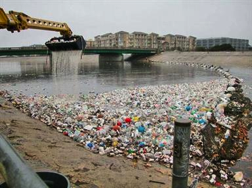
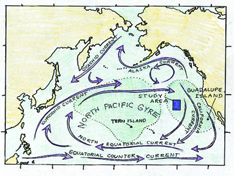
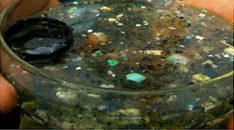
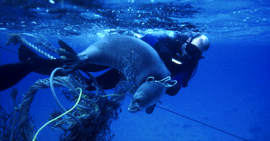
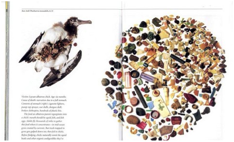
October 23rd, 2011 at 6:00 pm
I can not believe that the garbage pile is as big as Texas. Human beings really suck sometimes! Are people trying to at least minimize some of the waste (by catching it in nets or anything)?
October 23rd, 2011 at 6:48 pm
No see the problem is that most of the plastic has been broken into millions of tiny pieces that there is no way you could make a difference by filtering it out. GreenPeace tries this every year, but honestly its not the best way to go. The most we can do is recycle and try to cut down on our waste so we can delay the problem getting worse
October 23rd, 2011 at 7:19 pm
I bet that decades ago when oil was cheap and it seemed like a good idea to use plastic for nearly everything, very few people were thinking about where all that plastic would end up. It makes me wonder what we are doing now that we won’t see the ramifications of until far in the future. Who should we be listening to now before it’s too late?
October 23rd, 2011 at 9:08 pm
My family tends to reuse plastic bags as much as possible rather than throw them out. However, I guess if they became dirty, most people would find it convenient to throw them out than try and clean them for reuse. I did not know there were ways to recycle these plastic bags. What really scares me is the effects on humans. This is why there was a major concern over reusing plastic bottles. The compounds could seep into the liquids.
October 24th, 2011 at 12:46 am
But even though we know we should avoid plastics, I admit that it is cheap, and the most convinient to use. People will unlikely to change. I was trying to replace paper-made container for sushi and other take-out places around my high school as one of my project, but it was really hard to change. There are almost no effective alternates that are known.
October 24th, 2011 at 1:53 pm
That video was so terrifying. I cannot believe that that much trash exists in the ocean! Were there a lot of new reports on this because it is surprising that this isn’t more well known? I like how you chose this topic because it is one that we can all take an initiative in to combat. I rarely take plastic bags from stores as I bring reusable bags or my backpack. Concerning the comment about dirty reusable bags, they are easily put in the laundry so that shouldn’t be an excuse for people. I am just stunned how all that other plastic that gets thrown away and ends up in the oceans without anyone noticing. Thanks for the post!! I’m going to go yell at my friends about plastic now : )
October 30th, 2011 at 11:02 am
I wonder how many times I was too lazy to bring a plastic cup or can to the recycling bin so I put it into the trash. Now, I wonder how many of the floating plastic that is killing the animals and organisms in the sea is mine. This is something that is not brought up often and it is something that needs to be dealt with immediately.
When I visited my home in S.Korea last year after not living there for a long time, I noticed that their recycling system is beyond superb compared to that of Canada. You have buy specific garbage bag and you have to throw it out one certain days. Since you are buying the garbage bag, people tend to produce less garbage. In addition, you recycle everything. I mean EVERYTHING. There is a pile where you recycle plastic bags according to their color, you differentiate between different types of plastic bottles and you even recycle used pens. If that type of recycling is possible in one part of the world, why can’t Canada do the same to fight this war on plastic?